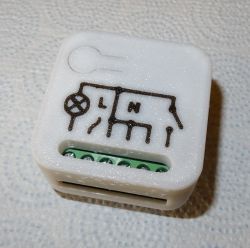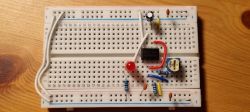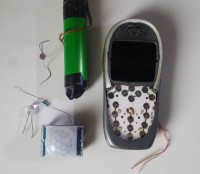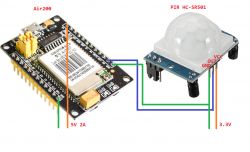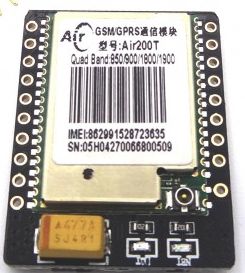What is it and how did it start
Recently I did an alarm with a gsm notification. But the alarm itself communicated with the phone via a serial connector, providing number identification and specific information sent by SMS. However, in many cases, the details of motion detection are irrelevant. It is important that we get an immediate notification on the phone that the sensor has detected movement. So I came up with a method of implementing this idea based only on the old gsm telephone and motion sensor. No Arduino, no microcontroller!
What is the idea?
However, the telephone used must have a specific function: a long press on the key dials the number. WITHOUT green phone confirmation. My siemens s55 can do it. Thanks to this, we can directly from the motion sensor send an impulse "pressing" a specific key on the phone
and dial the number. To make the system more universal, I soldered a photoresistor instead of a key on the phone. If it's dark, it doesn't do anything, it's (almost) a break. If the sensor detects motion, it will light up a diode that illuminates the photoresistor causing (almost) a short circuit which the phone will recognize as pressing the button
How to build a layout?
First get a phone that dials one-touch number without confirmation with the green handset. Then "program" the number the phone will ring during an alarm. The system (sensor and telephone) needs 3.3V to 5V for operation, but will work more stable if it is powered by a battery. The one from my siemens was useless, so I replaced it with a soldered 18650 cell, from which I immediately supply the motion sensor. A standard Siemens charger is constantly charging the battery.
First you need to solder the motion sensor with a resistor and a diode. The resistor's task is to limit the current to 10 ... 15mA so that the diode does not burn. If the 500ohm resistor works - leave it on. If the diode is too weak or the current consuming is less than 10mA - give a smaller resistor. If the motion sensor is stable, connect it permanently to the photoresistor. Both components must be protected from light. In the end, solder the photoresistor to the phone so that its shorting causes the "pressing" of the key.
Commissioning and operation.
After turning on the system, the motion sensor starts in a few seconds, the phone, fortunately, needs more time. In this way, the motion sensor will determine the operating conditions before the phone is ready to "ring". If the sensor detects motion, the "LED" will light up, which will cause a decrease in photoresistor resistance, which the phone will read as pressing the button and call the selected number.
Request. Even if you do not intend to build such a system, but you have old GSM phones at home, let us know which phones have the ability to dial with a long press.
YT movie showing action
https://youtu.be/Yl2M2v_Lsyo
Photos:
elements needed for construction
wiring diagram
Thomas
Recently I did an alarm with a gsm notification. But the alarm itself communicated with the phone via a serial connector, providing number identification and specific information sent by SMS. However, in many cases, the details of motion detection are irrelevant. It is important that we get an immediate notification on the phone that the sensor has detected movement. So I came up with a method of implementing this idea based only on the old gsm telephone and motion sensor. No Arduino, no microcontroller!
What is the idea?
However, the telephone used must have a specific function: a long press on the key dials the number. WITHOUT green phone confirmation. My siemens s55 can do it. Thanks to this, we can directly from the motion sensor send an impulse "pressing" a specific key on the phone
and dial the number. To make the system more universal, I soldered a photoresistor instead of a key on the phone. If it's dark, it doesn't do anything, it's (almost) a break. If the sensor detects motion, it will light up a diode that illuminates the photoresistor causing (almost) a short circuit which the phone will recognize as pressing the button
How to build a layout?
First get a phone that dials one-touch number without confirmation with the green handset. Then "program" the number the phone will ring during an alarm. The system (sensor and telephone) needs 3.3V to 5V for operation, but will work more stable if it is powered by a battery. The one from my siemens was useless, so I replaced it with a soldered 18650 cell, from which I immediately supply the motion sensor. A standard Siemens charger is constantly charging the battery.
First you need to solder the motion sensor with a resistor and a diode. The resistor's task is to limit the current to 10 ... 15mA so that the diode does not burn. If the 500ohm resistor works - leave it on. If the diode is too weak or the current consuming is less than 10mA - give a smaller resistor. If the motion sensor is stable, connect it permanently to the photoresistor. Both components must be protected from light. In the end, solder the photoresistor to the phone so that its shorting causes the "pressing" of the key.
Commissioning and operation.
After turning on the system, the motion sensor starts in a few seconds, the phone, fortunately, needs more time. In this way, the motion sensor will determine the operating conditions before the phone is ready to "ring". If the sensor detects motion, the "LED" will light up, which will cause a decrease in photoresistor resistance, which the phone will read as pressing the button and call the selected number.
Request. Even if you do not intend to build such a system, but you have old GSM phones at home, let us know which phones have the ability to dial with a long press.
YT movie showing action
https://youtu.be/Yl2M2v_Lsyo
Photos:
elements needed for construction
wiring diagram
Thomas
Cool? Ranking DIY



